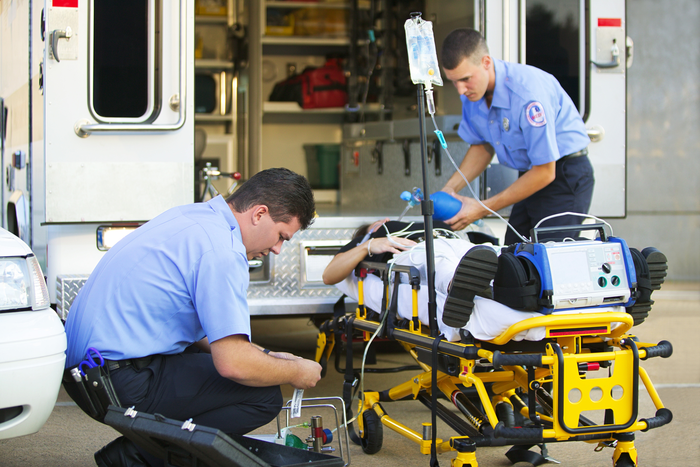
We tend to think of prehospital suctioning as a simple, straightforward treatment. You assemble your equipment, prep the patient, turn on the unit, and get to work clearing the airway. Easy, right?
In most cases, yes. Appropriate suctioning is not difficult, it requires basic technique, and there are no contraindications for its use. But that doesn’t mean it can't be dangerous. Like any medical treatment, suctioning can harm your patient. So today we’ll discuss three medical suction machine dangers and how you can avoid these pitfalls.
The first step in suctioning is to identify the need in your patient. Prehospital suctioning is used in the following instances:
- To maintain a patent airway
- To improve oxygenation and reduce the work of breathing
- To remove accumulated tracheobronchial secretions from the endotracheal tube
- To prevent pulmonary aspiration of blood and gastric fluids
- To prevent infection and atelectasis
- To remove tissue debris in the trauma patient
Once you have identified the need for suctioning, it’s time to get to work. But before you begin, let’s review three medical suction dangers.
Hypoxia
The greatest danger of suctioning is hypoxia. Suction is supposed to produce a patent airway, not induce hypoxia. And in the critical patient, such as a code or a trauma, the last thing you want is to deprive the patient of oxygen.
But hypoxia is only a danger in prolonged suctioning. It’s critical to keep suction time under 10 seconds. This may be challenging in the trauma patient, when copious blood is flowing into the oral cavity. These patients may require intermittent, long-term suctioning, but be sure to reoxygenate between suction events and to preoxygenate before each attempt.
Monitor your patient's O2 saturation, and maintain a sat of at least 94 percent. If you see the patient’s sats are dropping, preoxygenate using 100 percent 02 with assisted ventilations. Signs of hypoxia include:
- Changes in the color of the skin or mucosa (cyanosis)
- Confusion
- Tachycardia
- Tachypnea
- Shortness of breath
- Sweating
- Wheezing
Stay alert for signs of hypoxia and treat with supplemental oxygen when necessary.
Trauma
The second danger of medical suctioning is traumatizing airway tissues. This can occur in overaggressive suctioning, or when poor technique is employed. The mucosal lining of the nose, mouth, and oropharynx is thin and delicate. Careless maneuvering of the suction catheter can tear these tissues, causing bleeding and creating an even greater threat of airway compromise.
This is especially the case in geriatric patients. As bodies age, the mucosa, like the skin, become thinner and more prone to bleeding. This issue is compounded by patients taking blood thinners. Elderly patients are also likely to have extensive dental work, which can become dislodged during careless suctioning, producing obstructions. Suction with care when treating older patients, and consider dialing back the pressure to prevent trauma.
The same can be said of pediatrics. Suctioning children and infants can be dangerous if a cautious approach is not employed. Their smaller oral and nasal cavities require careful guidance of the suction tip, as well as reduced pressure to prevent trauma. Use an appropriate sized tip—the smaller the better, and be careful to prevent hypoxia, which will set in faster than in adults.
In patients suffering from facial trauma, when the airway is clogged with blood and tissue, use caution when suctioning to prevent additional trauma to these already-damaged regions. Broken teeth can be forced down into the airway, so avoid blind or overaggressive suctioning.
Equipment Failure
The final medical suction danger to discuss is the easiest to prevent: equipment failure. Maintaining your equipment is one of the simplest ways to ensure your suction unit will function when you need it. Here are our suggestions:
- Check the unit at the start of each shift—never assume it is charged and working.
- Replace old or depleted batteries, so you always have power.
- Inventory your accessories each shift, to ensure you have an assortment of tips for any suction emergency.
- Make sure the unit is clean and disinfected after each use, to avoid passing on dangerous pathogens to patients and personnel.
- Follow the manufacturer’s guidelines for annual maintenance and warranty adherence.
By maintaining your portable suction unit, you minimize the worry about it malfunctioning at those critical moments. But even maintaining your unit is pointless if you don’t bring it with you on the call. Here are our recommendations:
- Place the unit alongside other advanced life support gear, so it’s an easy grab.
- Pack a small unit in the airway or trauma bag, so it’s always at your side.
- Practice suction technique during mega-code scenarios, so that it becomes ingrained in the ALS lineup.
- Have plenty of backups on hand, for MCI scenarios or in the event your unit malfunctions
Yes, there are dangers when it comes to medical suction, but you can overcome these dangers with a bit of care, caution, and preplanning.















